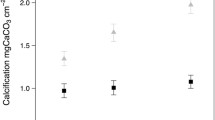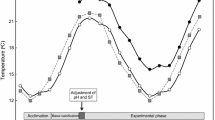Abstract
Marine organisms inhabiting environments where pCO2/pH varies naturally are suggested to be relatively resilient to future ocean acidification. To test this hypothesis, the effect of elevated pCO2 was investigated in the articulated coralline red alga Corallina elongata from an intertidal rock pool on the north coast of Brittany (France), where pCO2 naturally varied daily between 70 and 1000 μatm. Metabolism was measured on algae in the laboratory after they had been grown for 3 weeks at pCO2 concentrations of 380, 550, 750 and 1000 μatm. Net and gross primary production, respiration and calcification rates were assessed by measurements of oxygen and total alkalinity fluxes using incubation chambers in the light and dark. Calcite mol % Mg/Ca (mMg/Ca) was analysed in the tips, branches and basal parts of the fronds, as well as in new skeletal structures produced by the algae in the different pCO2 treatments. Respiration, gross primary production and calcification in light and dark were not significantly affected by increased pCO2. Algae grown under elevated pCO2 (550, 750 and 1000 μatm) formed fewer new structures and produced calcite with a lower mMg/Ca ratio relative to those grown under 380 μatm. This study supports the assumption that C. elongata from a tidal pool, where pCO2 fluctuates over diel and seasonal cycles, is relatively robust to elevated pCO2 compared to other recently investigated coralline algae.




Similar content being viewed by others
References
Adey WH (1998) Coral reefs: algal structured and mediated ecosystems in shallow, turbulent, alkaline waters. J Phycol 34:393–406
Adey WH, Macintyre IG (1973) Crustose coralline algae: a re-evaluation in the geological sciences. Geol Soc Am Bull 84:883–904
Agegian CR (1985) The biogeochemical ecology of Porolithon gardineri (Foslie). Department of Oceanography, Honolulu
Andersson A, Mackenzie F, Bates N (2008) Life on the margin: implications of ocean acidification on Mg-calcite, high latitude and cold-water marine calcifiers. Mar Ecol Prog Ser 373:265–273
Anthony KRN, Kline DI, Diaz-Pulido G, Dove S, Hoegh-Guldberg O (2008) Ocean acidification causes bleaching and productivity loss in coral reef builders. Proc Nat Acad Sci 105:17442–17446
Barrón C, Duarte C, Frankignoulle M, Borges A (2006) Organic carbon metabolism and carbonate dynamics in a Mediterranean seagrass (Posidonia oceanica), meadow. Estuaries Coasts 29:417–426
Borowitzka MA (1981) Photosynthesis and calcification in the articulated coralline red algae Amphiroa anceps and A. foliacea. Mar Biol 62:17–23
Büdenbender J, Riebesell U, Form A (2011) Calcification of the Arctic coralline red algae Lithothamnion glaciale in response to elevated CO2. Mar Ecol Prog Ser 441:79–87
Caldeira K, Wickett ME (2003) Anthropogenic carbon and ocean pH. Nature 425:362–366
Chave KE (1954) Aspects of the biogeochemistry of magnesium 1. Calcareous marine organisms. J Geol 62:266–283
Chisholm JRM, Gattuso JP (1991) Validation of the alkalinity anomaly technique for investigating calcification and photosynthesis in coral reef communities. Limnol Oceanogr 36:1231–1239
Cumani F, Bradasi F, Pascoli AD, Bressan G (2010) Marine acidification effects on reproduction and growth rates of Corallinaceae spores (Rhodophyta). CIESM Congress Proceedings 39: 735
Dickson AG, Millero FJ (1987) A comparison of the equilibrium constants for the dissociation of carbonic acid in seawater media. Deep Sea Res 34:1733–1743
Dickson AG, Sabine CL, Christian JR (2007) Guide to best practices for ocean CO2 measurements. PICES Special Publication 3, pp 191
Dupont S, Dorey N, Stumpp M, Melzner F, Thorndyke M (2012) Long-term and trans-life-cycle effects of exposure to ocean acidification in the green sea urchin Strongylocentrotus droebachiensis. Marine Biology online first: 1–9
Form AU, Riebesell U (2012) Acclimation to ocean acidification during long-term CO2 exposure in the cold-water coral Lophelia pertusa. Glob Change Biol 18:843–853
Foster MS (2001) Rhodoliths: between rocks and soft places. J Phycol 37:659–667
Gao K, Zheng Y (2010) Combined effects of ocean acidification and solar UV radiation on photosynthesis, growth, pigmentation and calcification of the coralline alga Corallina sessilis (Rhodophyta). Glob Change Biol 16:2388–2398
Gao K, Aruga Y, Asada K, Ishihara T, Akano T, Kiyohara M (1993) Calcification in the articulated coralline alga Corallina pilulifera, with special reference to the effect of elevated CO2 concentration. Mar Biol 117:129–132
Hall-Spencer JM, Rodolfo-Metalpa R, Martin S, Ransome E, Fine M, Turner SM, Rowley SJ, Tedesco D, Buia M-C (2008) Volcanic carbon dioxide vents show ecosystem effects of ocean acidification. Nature 454:96–99
Hardie LA (1996) Secular variation in seawater chemistry: an explanation for the coupled secular variation in the mineralogies of marine limestones and potash evaporites over the past 600 m.y. Geology 24:279–283
Haugan PM, Drange H (1996) Effects of CO2 on the ocean environment. Energ Convers Manage 37:1019–1022
Hofmann L, Yildiz G, Hanelt D, Bischof K (2011) Physiological responses of the calcifying rhodophyte, Corallina officinalis (L.), to future CO2 levels. Marine Biology Online 1–10
Hover VC, Walter LM, Peacor DR (2001) Early marine diagenesis of biogenic aragonite and Mg-calcite: new constraints from high-resolution STEM and AEM analyses of modern platform carbonates. Chem Geol 175:221–248
Huggett J, Griffiths CL (1986) Some relationships between elevation, physico-chemical variables and biota of the intertidal rock pools. Mar Ecol Prog Ser 29:189–197
Hurd CL, Hepburn CD, Currie KI, Raven JA, Hunter KA (2009) Testing the effects of ocean acidification on algal metabolism: considerations for experimental designs. J Phycol 45:1236–1251
Hurd CL, Cornwall CE, Currie K, Hepburn CD, McGraw CM, Hunter KA, Boyd PW (2011) Metabolically-induced pH fluctuations by some coastal calcifiers exceed projected 22nd century ocean acidification: a mechanism for differential susceptibility? Glob Change Biol 17:3254–3262
Israel A, Hophy M (2002) Growth, photosynthetic properties and Rubisco activities and amounts of marine macroalgae grown under current and elevated seawater CO2 concentrations. Glob Change Biol 8:831–840
Jeffrey SW, Humphrey GF (1975) New spectrophotometric equations for determining chlorophylls a, b, c1 and c2 in higher plants, algae and natural phytoplankton. Biochem Physiol Pflanz 167:191–194
Jokiel P, Rodgers K, Kuffner I, Andersson A, Cox E, Mackenzie F (2008) Ocean acidification and calcifying reef organisms: a mesocosm investigation. Coral Reefs 27:473–483
Kamenos NA, Cusack M, Moore PG (2008) Coralline algae are global palaeothermometers with bi-weekly resolution. Geochim Cosmochim Acta 72:771–779
Kolesar PT (1978) Magnesium in calcite from a coralline alga. J Sediment Res 48:815–819
Kuffner IB, Andersson AJ, Jokiel PL, Rodgers KuS, Mackenzie FT (2008) Decreased abundance of crustose coralline algae due to ocean acidification. Nature Geosci 1:114–117
Martin S, Gattuso J-P (2009) Response of Mediterranean coralline algae to ocean acidification and elevated temperature. Glob Change Biol 15:2089–2100
Martin S, Clavier J, Guarini J-M, Chauvaud L, Hily C, Grall J, Thouzeau G, Jean F, Richard J (2005) Comparison of Zostera marina and maerl community metabolism. Aquat Bot 83:161–174
Martin S, Castets M-D, Clavier J (2006) Primary production, respiration and calcification of the temperate free-living coralline alga Lithothamnion corallioides. Aquat Bot 85:121–128
Martin S, Clavier J, Chauvaud L, Thouzeau G (2007) Community metabolism in temperate maerl beds. I. Carbon and carbonate fluxes. Mar Ecol Prog Ser 335:19–29
Martin S, Rodolfo-Metalpa R, Ransome E, Rowley S, Buia M-C, Gattuso J-P, Hall-Spencer J (2008) Effects of naturally acidified seawater on seagrass calcareous epibionts. Biol Lett 4:689–692
Morris S, Taylor AC (1983) Diurnal and seasonal variation in physico-chemical conditions within intertidal rock pools. Estuar Coast Shelf Sci 17:339–355
Morse JW, Andersson AJ, Mackenzie FT (2006) Initial responses of carbonate-rich shelf sediments to rising atmospheric pCO2 and “ocean acidification”: role of high Mg-calcites. Geochim Cosmochim Acta 70:5814–5830
Moulin L, Catarino AI, Claessens T, Dubois P (2011) Effects of seawater acidification on early development of the intertidal sea urchin Paracentrotus lividus (Lamarck 1816). Mar Pollut Bull 62:48–54
Mucci A, Morse JW (1983) The incorporation of Mg2 + and Sr2 + into calcite overgrowths: influences of growth rate and solution composition. Geochim Cosmochim Acta 47:217–233
Müller G, Irion G, Förstner U (1972) Formation and diagenesis of inorganic Ca − Mg carbonates in the lacustrine environment. Naturwissenschaften 59:158–164
Nelson WA (2009) Calcified macroalgae—critical to coastal ecosystems and vulnerable to change: a review. Mar Freshw Res 60:787–801
Poole LJ, Raven JA (1997) The biology of Enteromorpha. Prog Phycol Res 12:1–148
Porzio L, Buia MC, Hall-Spencer JM (2011) Effects of ocean acidification on macroalgal communities. J Exp Mar Biol Ecol 400:278–287
Ragazzola F, Foster LC, Form A, Anderson PSL, Hansteen TH, Fietzke J (2012) Ocean acidification weakens the structural integrity of coralline algae. Global Change Biology 18:2804–2812
Raven JA (2011) Effects on marine algae of changed seawater chemistry with increasing atmospheric CO2. Biol Environ Proceed Royal Ir Acad 111B:1–17
Raven J, Hurd C (2012) Ecophysiology of photosynthesis in macroalgae. Photosynth Res 113:105–125
Raven JA, Giordano M, Beardall J, Maberly SC (2012) Algal evolution in relation to atmospheric CO2: carboxylases, carbon-concentrating mechanisms and carbon oxidation cycles. Philos Trans R Soc B Biol Sci 367:493–507
Ries JB (2006) Mg fractionation in crustose coralline algae: geochemical, biological, and sedimentological implications of secular variation in the Mg/Ca ratio of seawater. Geochim Cosmochim Acta 70:891–900
Ries JB (2011) Skeletal mineralogy in a high-CO2 world. J Exp Mar Biol Ecol 403:54–64
Ries JB, Cohen AL, McCorkle DC (2009) Marine calcifiers exhibit mixed responses to CO2-induced ocean acidification. Geology 37:1131–1134
Semesi IS, Kangwe J, Björk M (2009) Alterations in seawater pH and CO2 affect calcification and photosynthesis in the tropical coralline alga, Hydrolithon sp. (Rhodophyta). Estuar Coast Shelf Sci 84:337–341
Smith S, Key G (1975) Carbon dioxide and metabolism in marine environments. Limnol Oceanogr 20:493–495
Smith AD, Roth AA (1979) Effect of carbon dioxide concentration on calcification in the red coralline alga Bossiella orbigniana. Mar Biol 52:217–225
Solomon S, Quin D, Manning M, Chen Z, Marquis M, Averyt KB, Tignor M, Miller HL (eds) (2007) Contribution of Working Group I to the Fourth Assessment Report of the Intergovernmental Panel on Climate Change, 2007. Cambridge University Press, Cambridge
Steneck RS (1986) The ecology of coralline algal crusts: convergent patterns and adaptive strategies. Ann Rev Ecol Syst 17:273–303
Truchot JP, Duhamel-Jouve A (1980) Oxygen and carbon dioxide in the marine intertidal environment: diurnal and tidal changes in rockpools. Respir Physiol 39:241–254
Zou D, Gao K, Luo H (2011a) Short- and long term effects of elevated CO2 on photosynthesis and respiration in the marine macroalga Hizikia fusiformis (Sargassaceae, Phaeophyta) grown at low and high N supplies. J Phycol 47:87–97
Zou D, Gao K, Xia J (2011b) Dark respiration in the light and in darkness of three marine macroalgal species grown under ambient and elevated CO2 concentrations. Acta Oceanologica Sinica 30:1–7
Acknowledgments
We are grateful to Niels Oskarsson at the Institute of Earth Sciences, University of Iceland, for invaluable advice and assistance with skeletal analysis. We also thank Erwan Ar Gall for his help with species determination. The anonymous reviewers and editor are gratefully acknowledged for their constructive comments and suggestions. This study is funded by the Marine Research Institute, Iceland and is a contribution to the European Project on Ocean Acidification (EPOCA) that received funding from the European Community’s Seventh Framework Programme (FP7/2007-2013) under agreement n°211384.
Author information
Authors and Affiliations
Corresponding author
Additional information
Communicated by S. Dupont.
An erratum to this article is available at http://dx.doi.org/10.1007/s00227-014-2517-4.
Rights and permissions
About this article
Cite this article
Egilsdottir, H., Noisette, F., Noël, L.ML.J. et al. Effects of pCO2 on physiology and skeletal mineralogy in a tidal pool coralline alga Corallina elongata . Mar Biol 160, 2103–2112 (2013). https://doi.org/10.1007/s00227-012-2090-7
Received:
Accepted:
Published:
Issue Date:
DOI: https://doi.org/10.1007/s00227-012-2090-7




